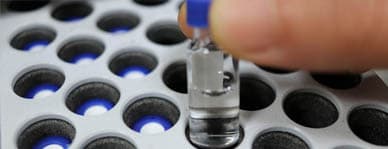The Complete Solution For Mitomycin Bladder Instillation
Edge Pharma offers compounded Mitomycin bladder instillation syringe kits that include a 40mg/40mL pre-filled unit-dose syringe of Mitomycin, a closed system transfer device (CSTD), and catheter tip. The CSTD is attached by Edge in an ISO 5 environment according to CGMP. This solution solves the USP 800 hazardous compounding challenge many hospitals and clinics now face when trying to administer Mitomycin. Since the product comes ready-to-administer, you do not need to compound a hazardous drug in your facility. Edge specializes in offering hazardous compounding services for organizations, making the transition to USP 800 compliance easier.
See Also:
Mitomycin Ophthalmic Solution syringes
Mitomycin C Bladder Instillation Kit
Mitomycin C sterile intravesical solution, preservative free. Closed system transfer device (CSTD) and catheter tip included with kit.
Available Dosage=40 mg*
Syringe Volume=40 mL
*Custom dosages available upon request
Since it is in final dosage form, the kit does not need to be separated during storage from other medications, according to USP 800 standards. Please see below:
From USP 800 Hazardous Drugs – Handling in Health Care Settings 5.2
“Antineoplastic HDs requiring manipulation other than counting or repackaging of final dosage forms and any HD API must be stored separately from non-HDs in a manner that prevents contamination and personnel exposure. These HDs must be stored in an externally ventilated, negative-pressure room with at least 12 air changes per hour (ACPH). Nonantineoplastic, reproductive risk only, and final dosage forms of antineoplastic HDs may be stored with other inventory if permitted by entity policy.”
Each year in the U.S., some 56,000 men and 18,000 women are diagnosed with bladder cancer, according to the Centers for Disease Control. Smoking is a major risk for bladder cancer.[1] Exposure to certain industrial chemicals, called aromatic amines, also increases the risk of developing bladder cancer, according to a report by the American Cancer Society. “Workers in other industries that use certain organic chemicals also may have a higher risk of bladder cancer,” the report continues. “Industries carrying higher risks include makers of rubber, leather, textiles, and paint products as well as printing companies. Other workers with an increased risk of developing bladder cancer include painters, machinists, printers, hairdressers (probably because of heavy exposure to hair dyes), and truck drivers (likely because of exposure to diesel fumes).”[2]
Depending on a patient’s stage of cancer, and other factors, different treatments are recommended to treat bladder cancer. They include: bladder surgery, intravesical therapy, chemotherapy, radiation, immunotherapy, and targeted therapy. Sometimes more than one of the treatments may be used.[3]
While Bacillus Calmette-Guerin (BCG) is the intravesical immunotherapy used most often to treat early-stage bladder cancer, Mitomycin is the most common drug used for intravesical chemotherapy.[4]
In intravesical therapy, after the surgical removal of the tumor, mitomycin is inserted by catheter directly into the bladder. According to the American Urological Association, “the drug works on cells that line the bladder, without having major effects on other parts of the body. This avoids the types of side effects often caused by other types of chemotherapy, such as hair loss.” The association reports that studies show the use of mitomycin reduces the rates of recurrence of cancer by 10-15 percent.[5]
[1] Centers for Disease Control, online article, Bladder Cancer https://www.cdc.gov/
[2] American Cancer Society, online article, Bladder Cancer Risk Factors https://www.cancer.org/
[3] American Cancer Society, online article, Treating Bladder Cancer https://www.cancer.org/
[4] American Cancer Society, online article, Intravesical Therapy for Bladder Cancer https://www.cancer.org/
[5] American Urological Association, online patient magazine, Non-muscle Invasive Bladder Cancer: Intravesical Therapy https://www.urologyhealth.org/
References
Mian, Badar. “Immediate Post-TURBT Mitomycin Instillation Reduces Recurrence Risk.” Urology Times, Vol. 45 Issue 12, Nov. 2017: p. 9.
“Mitomycin C (MMC) instillation within 24 hours after transurethral resection (TURBT) of non-muscle invasive bladder cancer (NMIBC) significantly reduces the risk of recurrence and delays the time to recurrence.”
“The recurrence risk in the entire cohort was significantly lower at 27% in the immediate instillation group compared to 36% in the delayed instillation group (p<.001).”
Register To Order Online
We are currently licensed to sell to all US states except Alabama and Virginia. Please fill the form below to create an account. Medical, DEA, or hospital pharmacy licenses will be required to order Mitomycin C instillation kits.
Create an account to order
Log-In if you have an account

